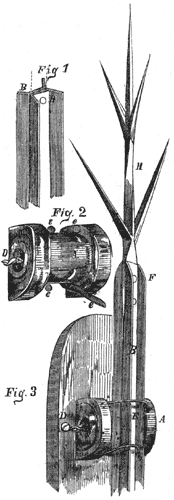[Trade Journal]
Publication: Scientific American
New York, NY, United States
vol. 10, no. 5, p. 36, col. 1-3
New Inventions.
Lyon's Copper Lightning Conductor.
The annexed figures represent an improvement in Lightning Conductors, for which a patent was granted to Amos Lyon, of Worcester, Mass., on the 11th of July last.
Figure 1 is a perspective view of a section of the conductor; figure 2 is a like view of one of the glass insulators employed, and figure 3 is a perspective view of a conductor secured in position.
The nature of the invention consists mainly in the use of sheet copper (or other metal to produce the same result) made in such form for a lightning rod as to present to the electrical atmosphere a proportionally large amount of surface with a smaller amount of metal than is ordinarily used. The conductor is made of thin sheet copper like that is used for making common kettles. A sheet of this copper, say about five feet long, is cut into strips of about three-fourths of an inch wide, or more as may be desired, and is bent or locked up to form a ledge on each side, like a square gutter of two sides and a bottom, but no top; two of these are rivetted together back to back, as shown by B B, figure 1, forming the conductor, which therefore is made of these strips of copper thus united together, and rivetted so as to form it of any length required.
 |
Figure 2 represents an insulator, A, which is used to bind the conductor to a building. It is made of glass with an opening through its center, is flattened on the side, D, next to the house to fit snug to it, and has its middle part formed outside with a groove to receive the conductor between its two raised ends. A double wire, e e, is passed around the conductor above, and fastened below the insulator as at E, figure 3, to clasp it firm in its groove; another wire is passed through the interior of A, and secured by screws or pins to the building to hold the insulator to the house. Other insulators may be used, but this is a very good one. The upper part, H, of the conductor is formed with a number of points, and its lower end is flattened and rivetted between the two middle sides of the conductor, as at F. This method of forming copper conductors is exceedingly simple. Copper is eight times as good as iron, (of the same section) in conducting power, and therefore to be preferred to iron. This conductor allows of a better continuous connection than by links, and it is of great importance to have the connection as perfect as possible.
In the erection of lightning rods, great care should be exercised to have the lower end buried in the ground some distance beneath the surface, where the soil is always moist, or to have it run into a well. If the lower end of the rod be buried in dry charcoal, as has been the practice with some who were ignorant of the principles of erecting them, it will fail to perform its offices. A lightning rod is simply a road to transmit the electricity from the surcharged atmosphere into the earth - to establish an equilibrium, and to do this the earth must form part of the circuit. Dry earth is a non-conductor, especially dry sand, hence the necessity of having the lower end of the rod buried in moist earth.
For the information of all those who desire to become fully acquainted with the merits of lightning rods, their offices and nature, Mr. Lyon has published an interesting pamphlet, in which he discusses with philosophic ability the deep and intricate questions of "man's free will," "fore-ordination," and "the works of Providence." We had no idea that these questions were so intimately blended with lightning conductors, until we read Mr. L.'s pamphlet.
More information may be obtained by letter addressed to the patentee, at Worcester, Mass.
